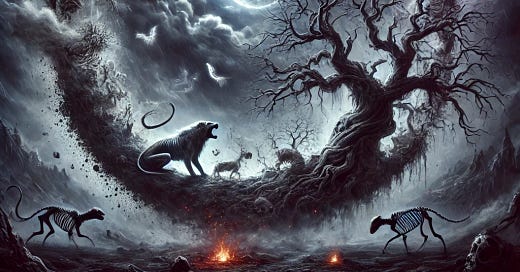Exploring Symbiotic Relationships with a System Addict
"One thing that is absolutely critical: you have to be willing to make mistakes regularly; there is nothing wrong with it." Bruce Kovner
I often explore reflections, connections, and a myriad of phrases to demystify macro trading.
Today, witnessing a wasp neutralize a cucumber beetle sparked an insightful analogy for explaining the intricate balance of nature, just as we see in financial markets.
Humans and wasps share an unspoken partnership. A symbiotic partnership. Though we often view wasps as pests, they are nature's pest controllers, keeping harmful insects in check. By preying on pests that would otherwise damage crops, they help reduce the need for chemical pesticides and support the biodiversity that sustains healthy ecosystems. In this way, wasps contribute to a healthier environment, even if their role is not always appreciated.
As pollinators, they ensure the growth of the crops and plants we rely on for food. Their work keeps the cycle of life turning, feeding the world.
Some insects also act as nature’s recyclers, breaking down organic matter into rich soil that nourishes future harvests.
Without these silent partners, agriculture would struggle, and the natural world would lose its resilience.
In this web of connections, humans, wasps, and insects thrive together, each dependent on the other for balance and survival.
What does this have to do with macro trading?
Everything. Let's take a journey through time.
3000 BC, Gold/Silver: Traded in ancient Mesopotamia, these were the original valuable and durable currencies.
600 BC, Gold Coins: Lydia introduced the first stamped coins, marking the beginning of gold's monetary use.
12th Century, Corporate Bonds: The Venetian government issued bonds to fund wars and territorial expansions, pioneering public finance.
1530s, Commodities: The Antwerp Bourse, the first commodity exchange, began in Belgium, allowing traders to hedge against the volatility of long-distance trade.
1602, Stocks: The Dutch East India Company issued the first public company shares.
1636, Options Trading: Early forms of options began with tulip bulb futures in Holland.
1710s, Futures Contracts: The Dojima Rice Exchange in Japan formalized futures trading contracts.
1859, Oil: Edwin Drake successfully drilled the first oil well in Pennsylvania, USA.
1880, Currency (Foreign Exchange): The gold standard was established, formalizing modern foreign exchange markets.
To grasp macro trading, start with understanding currency—gold and silver were the foundational mediums of exchange. Now it is the dollar.
Then recognize the importance of corporate bonds for Venice, not just for military purposes but also for economic stability and expansion.
Next, we add commodities: Belgium's exchange enabled merchants to manage the risks of volatile prices, securing costs and profits.
This history leads us to stocks, options, oil, and FOREX trading. Observing trends across these markets and understanding their interconnections gives us our trading edge. (Speaking of edge, did you catch our trade in the chat last night? Great move today. You could hold the puts you sold or wait a few more days.)
Let’s continue to explore global trends. Using our systems to find opportunities in the market.
Subscribe and stay connected.




